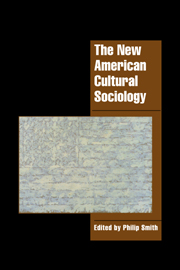PART III - Culture in action
Published online by Cambridge University Press: 18 January 2010
Summary
As Anne Kane remarked in her contribution to this book, a central problem in social theory has been to connect culture (the ideal, intangible, abstract) with the real world (the material, concrete, real). In other words to explain how culture can make a difference. Whilst various proposals can be located in the history of social scientific thought, contemporary American solutions are turning increasingly to theories of social action, locating an efficient cause in the actor (either individual or collective) rather than in the social systems. Remembering the introductory essay to this volume, this is a move that can be understood as reflecting the continuing positive influence of American pragmatism and the continuing negative influence of Parsons's structural functionalism. The central theme of this last selection of essays is the exploration of recent theoretical progress in this area.
Almost every essay contained in the earlier parts of this collection has made some reference to culture's consequences, even if in an implicit way. Legitimacy, power, status, stigma, self-and other-understandings, social conflict, attitudes, and institutional forms have all been invoked as products of cultural forms and meanings and the circumstances of their transmission and reception. Yet these sorts of issues have been somewhat tangential, with the research questions underlying the previous papers directing attention away from either a detailed demonstration of culture's consequences or a targeted exploration of the ways that it exerts a determinate impact on social life. By contrast the contributions to this third part place these matters at the center of their agenda. It begins with two theoretical arguments, one from Ann Swidler and the other from William Sewell, Jr.
- Type
- Chapter
- Information
- The New American Cultural Sociology , pp. 167 - 170Publisher: Cambridge University PressPrint publication year: 1998

